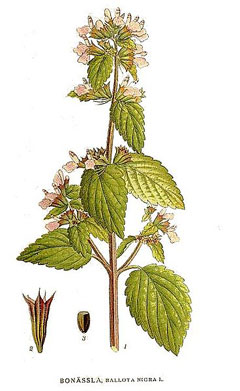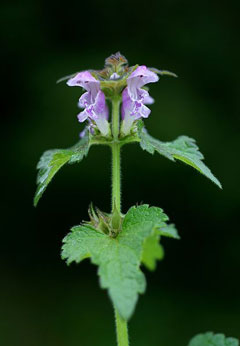 |
|
http://commons.wikimedia.org/wiki/File:98_Ballota_nigra.jpg |
 |
| http://commons.wikimedia.org/wiki/User:Böhringer |
Translate this page:
Summary
Physical Characteristics

 Ballota nigra is a PERENNIAL growing to 0.9 m (3ft) by 0.8 m (2ft 7in).
Ballota nigra is a PERENNIAL growing to 0.9 m (3ft) by 0.8 m (2ft 7in).
See above for USDA hardiness. It is hardy to UK zone 8 and is not frost tender. It is in flower from June to October. The species is hermaphrodite (has both male and female organs) and is pollinated by Bees.
Suitable for: light (sandy), medium (loamy) and heavy (clay) soils, prefers well-drained soil and can grow in nutritionally poor soil. Suitable pH: mildly acid, neutral and basic (mildly alkaline) soils. It can grow in full shade (deep woodland) semi-shade (light woodland) or no shade. It prefers moist soil.
UK Hardiness Map
US Hardiness Map
Synonyms
Plant Habitats
Woodland Garden Dappled Shade; Shady Edge;
Edible Uses
References More on Edible Uses
Medicinal Uses
Plants For A Future can not take any responsibility for any adverse effects from the use of plants. Always seek advice from a professional before using a plant medicinally.
Antianxiety Antiemetic Antispasmodic Stimulant Vermifuge
Black horehound has a long history of herbal use, though is not widely employed in modern herbalism because of its unpleasant flavour[238, 268]. Nonetheless, it does have a range of medicinal virtues, being especially effective in its action as an antiemetic[254]. In the past it was often used for treating problems connected with the respiratory system, convulsions, low spirits and the menopause, but present-day authorities differ over whether it was effective in these applications[254]. The whole plant is antiemetic, antispasmodic, expectorant, stimulant and vermifuge[4, 165, 238]. It is taken internally in the treatment of nervous dyspepsia, travelling sickness, morning sickness in pregnancy, arthritis, gout, menstrual disorders and bronchial complaints[238, 254]. The plant is harvested as it comes into flower and is dried for later use[238]. It should not be stored for longer than a year[238]. The fresh herb is sometimes used to make a syrup[238].
References More on Medicinal Uses
The Bookshop: Edible Plant Books
Our Latest books on Perennial Plants For Food Forests and Permaculture Gardens in paperback or digital formats.

Edible Tropical Plants
Food Forest Plants for Hotter Conditions: 250+ Plants For Tropical Food Forests & Permaculture Gardens.
More

Edible Temperate Plants
Plants for Your Food Forest: 500 Plants for Temperate Food Forests & Permaculture Gardens.
More

More Books
PFAF have eight books available in paperback and digital formats. Browse the shop for more information.
Shop Now
Other Uses
References More on Other Uses
Cultivation details
Prefers a well-drained soil in full sun or partial shade[134, 238]. Avoids acid soils in the wild but tolerates a pH down to 5 in cultivation[200]. This species is not hardy in the colder areas of the country, it tolerates temperatures down to between -5 and -10°c[200]. This species is widely grown in herb gardens, but little employed because of its strong flavour[238]. Its essential oil is used to adulterate the oil of white horehound (Marrubium vulgare)[238]. The leaves emit a most unpleasant smell when bruised, somewhat like stale perspiration[245]. Plants can self-sow freely when well-sited[238]. There is at least one named variety selected for its ornamental value[238]. The whole plant has an offensive odour[4].
References Carbon Farming Information and Carbon Sequestration Information
Temperature Converter
Type a value in the Celsius field to convert the value to Fahrenheit:
Fahrenheit:
The PFAF Bookshop
Plants For A Future have a number of books available in paperback and digital form. Book titles include Edible Plants, Edible Perennials, Edible Trees,Edible Shrubs, Woodland Gardening, and Temperate Food Forest Plants. Our new book is Food Forest Plants For Hotter Conditions (Tropical and Sub-Tropical).
Shop Now
Plant Propagation
Seed - sow spring or autumn in a greenhouse. The seed usually germinates in 3 - 6 weeks at 15°c[134]. Prick out the seedlings into individual pots when they are large enough to handle and plant them out into their permanent positions in the summer or following autumn. Division in spring. Larger divisions can be planted straight into their permanent positions whilst smaller clumps are best potted up and kept in a cold frame until they are growing away well.
Other Names
If available other names are mentioned here
Native Range
TEMPERATE ASIA: Cyprus, Iran, Israel, Lebanon, Syria, Turkey, Russian Federation-Ciscaucasia (Ciscaucasia), Armenia, Azerbaijan, Georgia, Russian Federation (Dagestan) EUROPE: Denmark, United Kingdom (England), Ireland, Sweden (south), Czechoslovakia, Austria, Belgium, Switzerland, Germany, Hungary, Netherlands, Poland, Russian Federation-European part (European part (south)), Belarus, Estonia, Lithuania, Latvia, Moldova, Ukraine (incl. Krym), Former Yugoslavia, Albania, Bulgaria, Greece (incl. Crete), Italy (incl. Sardinia, Sicily), Romania, Spain (incl. Baleares), France (incl. Corsica), Portugal AFRICA: Algeria (north), Morocco, Tunisia
Weed Potential
Right plant wrong place. We are currently updating this section.
Please note that a plant may be invasive in one area but may not in your area so it's worth checking.
Conservation Status
IUCN Red List of Threatened Plants Status :

Growth: S = slow M = medium F = fast. Soil: L = light (sandy) M = medium H = heavy (clay). pH: A = acid N = neutral B = basic (alkaline). Shade: F = full shade S = semi-shade N = no shade. Moisture: D = dry M = Moist We = wet Wa = water.
Now available:
Food Forest Plants for Mediterranean Conditions
350+ Perennial Plants For Mediterranean and Drier Food Forests and Permaculture Gardens.
[Paperback and eBook]
This is the third in Plants For A Future's series of plant guides for food forests tailored to
specific climate zones. Following volumes on temperate and tropical ecosystems, this book focuses
on species suited to Mediterranean conditions—regions with hot, dry summers and cool, wet winters,
often facing the added challenge of climate change.
Read More
Expert comment
Author
L.
Botanical References
17200
Links / References
For a list of references used on this page please go here
Readers comment
| Add a comment |
|
If you have important information about this plant that may help other users please add a comment or link below. Only comments or links that are felt to be directly relevant to a plant will be included. If you think a comment/link or information contained on this page is inaccurate or misleading we would welcome your feedback at [email protected]. If you have questions about a plant please use the Forum on this website as we do not have the resources to answer questions ourselves.
* Please note: the comments by website users are not necessarily those held by PFAF and may give misleading or inaccurate information.
To leave a comment please Register or login here All comments need to be approved so will not appear immediately.
|
|